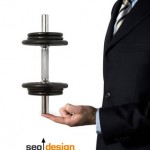 Are you yielding the highest possible return in search engines from optimizing your pages internal links? If not, then maybe it’s time for a link audit.
Are you yielding the highest possible return in search engines from optimizing your pages internal links? If not, then maybe it’s time for a link audit.
With so much time spent being myopic over link building and external links (development of one-way,reciprocal links or building your blog roll), people often forget that they have the most relevant authority site sitting right under their nose – their own pages.
Instead of looking past your own site, how could anything be more on-topic than the pages you have complete control over. If the pages are aged and already have page rank, then it’s just icing on the cake, this is the basis of link equity. By tweaking the structure of how your pages pass rank, you can essentially mold how search engines treat the content on those pages.
Did you know that SEO and ranking for highly competitive terms has more to do with website structure and internal links than external links? probably not, because so many schools of thought want you to think otherwise or simply go against the grain.
In fact a new site set up properly, themed and topically structured to reach a targeted or specific series of keywords, has a much greater chance of dominating the top 10 than an older site by comparison (in reference to content, internal links, the code in the pages, the naming conventions of the folders and filenames).
So let’s get started with tidying up the On-Page SEO factors that you ultimately have control over before you even consider Off Page SEO strategy. But just in case it’s too late and your site is seasoned and stuck in a rut, you can still apply any of the 10 methods below to clean house a bit and lighten the load to make each page more relevant.
When starting over is not an option, there are a few things you could do to salvage an older site by performing a content and link audit.
1. Make all of your links absolute, remove secondary keywords that are NOT RELEVANT.
Replace /pagename.html with http://www.yoursite.com/pagename.html this way when the pages age, they pull each other up in the search engine result pages. In addition, if your content gets scraped (copied) then at least the are pointing links back to your pages (so you get the back link).
2. Cap all out-bound links (links leaving the page to no more than 10 per page) or create a new page to keep the focus laser-like.
Less outbound links mean that each page has more link juice to pass to it’s own keywords and less energy being transfused or hemorrhaging away from the page. This becomes more apparent when you start building external links, how quickly the pages rise in the SERPs (search engine result pages).
3. Optimize your anchor text (the text in the link). Make sure your main keyword/phrase is on the page (at least one time) as well as in the title.
Use each link wisely as this will augment your page in search engines, anchor text is essentially screaming “hey, this is what this page is all about” so if used wisely you can literally anchor the context of the page and cement 4 or 5 choice terms that you would like to predominantly show up for “exact match style” when people are conducting searches.
4. Don’t try to optimize a page for more than 3 terms / keywords.
If you want to aim high and rank for competitive terms and variations of competitive keywords, keep the information on topic. Once a page reaches 750 words is enough, then create another page if you must with another variation of the keyword (this is also a great way to get a double listing in search engines, using two pages that dovetail off the others keywords). This tactic is for creating a ranking blockbuster, it is not to say that you cannot exceed that, but the term optimization also applies to the page size, so keep it lean and mean.
5. Use contextual links in the content, the higher on the page the better as links higher in the page are known to carry more weight in search engines vs. footer links.
If you are using contextual links (links from one page to other pages in the site, instead of navigation to pass page rank and flow) then make sure that you are using the main keywords for the page that you are trying to rank with. For example say I had page (a) and the link (1 of the 10 on the optimized page) was pointing to page (b) then make sure the anchor text (the text in the link) from page (a) was using the keywords for page (b) that you are trying to rank for. That way when it ages, it becomes the perfect back link for page (b) while in the meantime it creates relevance for your entire site. By linking your pages this way, each page supports the next like a dynamo (with the ideal link / anchor text to boot).
6. Keep your pages lean 20k or less (optimization also means loading time), this includes images and code bloat.
If you have Adobe Photoshop, open your images and use shift+control+alt+S then resize your images using jpeg compression. The jpeg format was designed not to lose resolution visually, but you can drastically reduce loading time, which definitely impacts where you rank.
7. Optimize your in-line code. Keep all of your java script and other programming code off page (in their own respective files and hyper-linked to the page like a style sheet).
CSS (cascading style sheets) are ideal, since they separate the content from the images and essentially provide the search engines what they want with the least amount of clutter and fuss. But if you must go old school and use tables and java script, then at least keep the java script off the page in a .js file and the link to it (using the same line of code that you would use for a style sheet). Here is an excellent css based (flash / java script looking DHTML menus that look great and are extremely lean)
8. Hone the focus of the page – Make sure your main keyword appears at least 2-4 times on the page and once in the h1 and a slight variation in an H2 tag.
This assures the person that they have found what they are looking for and allows them to quickly find the information they were originally looking for. Remember with so many options, the back button is only one click away.
Now you could go into advanced SEO where you can actually build deep links to pages and then the keywords transcend that page and eventually you start seeing the homepage appear in search engines (which may or may not have the keywords on the page). Or you could simply have a themed site (with highly relevant information) and build external links to the page (even though the keywords are not present on the page) and still rank for those terms.
So, just because you see people stuffing titles and overusing keywords doesn’t mean that is the only way to rank higher in search engines, sometimes less is more. But for the sake of the audit, let’s stick with the basics and use the time tested method (once in the title, once in the description, a few times on the page and once in the h1/h2 tags).
9. Augment your pages through the buddy system – Have at least 5 of your strongest pages concentrating their collective internal link-juice towards your newest rock star page (the page you wish to elevate and send forth as your messenger in the SERPs).
Sounds simple enough, this alone can determine which page is returned for which keywords. Aside from this, this is a great tactic when you are launching a new page.
10. Clean out pages that are off topic, rewrite them for present-tense relevance or remove all but a few links, rewrite the titles (65 characters or less) and the descriptions (2 sentences tops using the keywords only one time each) then republish the page and wait for the spiders to re-index your content. From there you can start building links to gain more elevation in the SERPs.
If none of these options seem industrial strength enough then you can always opt for;
1) Deleting off topic pages and using a 301 redirect to the homepage or a page that has the most relevance (if those pages were indexed).
2) Purchasing a new domain name comprised prominently of your main keywords, then 301 your old site to the new one (allow up to 30 days for the rankings to recover) build links and when it comes back in full force it will be stronger than ever, granted you utilized the basic fundamentals above.
This option is a last resort, ideally you could just add a blog on a subdirectory (with impeccable code) get it listed in blog directories and start generating new content frequently to increase spider activity until it revives your whole site through all of the increased pinging and spidering activity.
Make sure you give the spiders something juicy to chew on, otherwise you can’t really expect a reward. Even combining a title and description audit and removing the verbose words can be enough to bump your page up 10-20 positions, from there you can focus on off-page SEO to accomplish the rest.
These tips are essentially for non-content management systems as most CMS systems already have themed architecture and internal linking built in to the structure (at least to the degree where you can personalize it with a few custom plug-ins).
I have always been under the impression that it is good to have a combination of static and dynamic pages, but that is just my personal preference (that way you can control the prominent pages/internal links and page rank flow easier when you start building link externally). If your content is all withing a content management system (like word press), each page gets the equal amount of link juice, which can be a plus or a minus depending on your ranking strategy.
This is why I mentioned briefly that in a nutshell by adding a blog to an older static site, sometimes that can be enough with a few tweaks to the pages to jump start the search engine ascension process, however each site is unique and has it’s own internal and external link threshold.
Stay tuned for more SEO tips and techniques from Seo Design Solutions.










Good Hints, Zoomed.
It’s funny switching back and forth from doing my primarily social blog, OpTempo, and developing niche blogs. I don’t focus too heavily on SEO for OpTempo since most of its traffic is social, although search is climbing. I strongly focus on most of the techniques you mentioned for my niche blogs. They look austere in comparison but are beginning to pull in good search traffic.
Great post, with reference to keeping the number of external links down. I sometimes use a no follow tag to achieve the effect of reducing the outbound links. It seems to work well. Before this we tried excluding the site in the robots text file but it appears from a PR point of view Google still seems to follow the link it just dosnt index the page.
I really enjoyed your post as I am always looking to increase traffic flow and to get more traffic directly from the major search engines.
I find with blogs that it is easy to exceed 10 outbound links but I will go through my template and see what I can do to lower the number I have now.
I have moved a few already that I can live without.
thanks for your great post.
@ Frank:
It never hurts to build links to blogs using some nice terms, but I do agree, most of the traffic is flash in the pan stuff that grows over time, so it’s more like a theme/content ranking method. As those pages age, they will be even more effective.
@Tony & James:
Thanks for your comments, they are appreciated.
This tactic was more for static pages and word press already uses a form of theming and siloing from the category structure and the was they pass rank. In the instance that you are applying the same for a blog one suggestion is to try to keep the categories limited to about 15 max (but that is just a personal preference).
I will have to get our word press expert John Lamansky to discuss optimization tactics for blogs, he is putting something together right now and should be posting later this week.
Definitely a person to look out for in the future as his programming skills for Custom Word Press SEO Plug Ins and creating blogs that rank highly in search engines from his tweaks are some of the most dapper I have seen.
Good read. I concur I think if you have a great internal navigation architecture, it’s enough to rank for keyterms.
There are few absolutes in SEO. I’d imagine one you do this with your structure, then you’ve got to get those quality links to help make your site trusted, if your competition have :)
@Hobo:
Precisely, internal links first, then external links to reinforce trust. Don’t get me wrong, external links alone can produce rankings, but I like to use the analogy that the internal links and on page SEO is like the homing signal, without them the external links may not find their mark. Whereas with the method you coined, trust and rankings are the result.
great post here. I’d have to say I believe external linking is just as important as internal linking. You’re right though, people such as myself oversee our own sites sometimes and link out. Will start internally linking a bit more.
@Pablo:
After writing this post, I realized our internal links need optimization for our .html version of the site.
I have to practice what I preach and intend to perform a full internal link audit on all of our pages (in other sub directories)with more fitting optimized keywords.
Can’t wait to measure the results and see how it enhances long tail, short tail and competitive search phrase traffic.
While I agree with 99% of the measures you should consider the fact that when you “Replace /pagename.html with http://www.yoursite.com/pagename.html” you send an http-request each time to your server instead of just staying on the server where you are. This might hamper your sites performance.
I’d disagree with #1, if you make all of your links absolute then your web analytics is going to look crap as every users 2nd page will have your site as referrer.
@Tad:
The suggestion i s based on the preference that has roots in (a) long term backlinks vs. loading time and performance. The concept behind this was if you were creating an information silo/themed site using minimal outbound links per page. So 10 links with absolute references vs. 10 server side/root references is the quandary. I personally would rather have the 10 backlinks from our own site to other sub folders personally.
@Matt Hopkins:
Thanks for your comment, I still have to insist that for this tactic of strengthening the on-page SEO via a link and code audit it is no the analytics that are the focus, it’s hastening traction and eventual authority for all of your pages that is in question. This is a great way to create link oasis’s for multiple pages.
So instead of just having a rock star home page, you have multiple high ranking pages that can all pass “Strong Links” as well, and then using them all in concert to achieve a common keyword or series of keywords as a goal.
Hey, great information. I’m adding this link to our team reading list!
Thanks Rob, we appreciate it.
Hi,
“If your content gets scraped (copied) then at least they are pointing links back to your pages (so you get the back link)”. how this works i fail to understand. Can someone please explain to me. Please !
Thanks
Hi again Jeffrey. this is fast becoming one of my fave blogs. ..here we were just mulling over the idea of going back over the site with a final polish, cutting out the old & dead wood and then you write the definitive “how to” in case we forget anything :) nice one.
Hey Kev:
Sorry for the lapse in the reply. I have found on page to be one of the most overlooked aspects of SEO. If you don’t link to yourself with the anchors you want to rank for, then what is that telling search engines? That those phrases are not important. Simple logic denote, control what you can (your own links) instead of leaving relevance to chance. Thanks for visiting.
Wow, Thanxs For the tips
One of the most important aspects of your website infrastructure is your internal linking structure. You really need to give it some thought as to how to make the most use of your internal links.
Hi, i want to count the no. of internal and external links on my website.
Thanks for this article. It’s really useful.